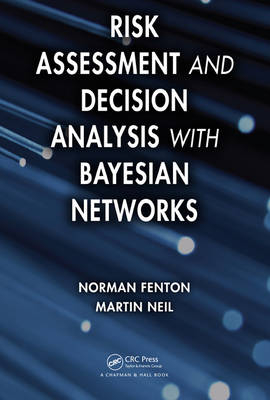
Risk Assessment and Decision Analysis with Bayesian Networks
Crc Press Inc (Verlag)
978-1-4398-0910-5 (ISBN)
- Titel erscheint in neuer Auflage
- Artikel merken
Provides all tools necessary to build and run realistic Bayesian network models
Supplies extensive example models based on real risk assessment problems in a wide range of application domains provided; for example, finance, safety, systems reliability, law, and more
Introduces all necessary mathematics, probability, and statistics as needed
The book first establishes the basics of probability, risk, and building and using BN models, then goes into the detailed applications. The underlying BN algorithms appear in appendices rather than the main text since there is no need to understand them to build and use BN models. Keeping the body of the text free of intimidating mathematics, the book provides pragmatic advice about model building to ensure models are built efficiently.
A dedicated website, www.BayesianRisk.com, contains executable versions of all of the models described, exercises and worked solutions for all chapters, PowerPoint slides, numerous other resources, and a free downloadable copy of the AgenaRisk software.
There Is More to Assessing Risk Than Statistics
Introduction
Predicting Economic Growth: The Normal Distribution and Its Limitations
Patterns and Randomness: From School League Tables to Siegfried and Roy
Dubious Relationships: Why You Should Be Very Wary of Correlations and
Their Significance Values
Spurious Correlations: How You Can Always Find a Silly `Cause’ of Exam
Success
The Danger of Regression: Looking Back When You Need to Look Forward
The Danger of Averages
When Simpson’s Paradox Becomes More Worrisome
Uncertain Information and Incomplete Information: Do Not Assume They Are
Different
Do Not Trust Anybody (Even Experts) to Properly Reason about Probabilities
Chapter Summary
Further Reading
The Need for Causal, Explanatory Models in Risk Assessment
Introduction
Are You More Likely to Die in an Automobile Crash When the Weather Is
Good Compared to Bad?
The Limitations of Common Approaches to Risk Assessment
Thinking about Risk Using Causal Analysis
Applying the Causal Framework to Armageddon
Summary
Further Reading
Measuring Uncertainty: The Inevitability of Subjectivity
Introduction
Experiments, Outcomes, and Events
Frequentist versus Subjective View of Uncertainty
Summary
Further Reading
The Basics of Probability
Introduction
Some Observations Leading to Axioms and Theorems of Probability
Probability Distributions
Independent Events and Conditional Probability
Binomial Distribution
Using Simple Probability Theory to Solve Earlier Problems and Explain
Widespread Misunderstandings
Summary
Further Reading
Bayes’ Theorem and Conditional Probability
Introduction
All Probabilities Are Conditional
Bayes’ Theorem
Using Bayes’ Theorem to Debunk Some Probability Fallacies
Second-Order Probability
Summary
Further Reading
From Bayes’ Theorem to Bayesian Networks
Introduction
A Very Simple Risk Assessment Problem
Accounting for Multiple Causes (and Effects)
Using Propagation to Make Special Types of Reasoning Possible
The Crucial Independence Assumptions
Structural Properties of BNs
Propagation in Bayesian Networks
Using BNs to Explain Apparent Paradoxes
Steps in Building and Running a BN Model
Summary
Further Reading
Theoretical Underpinnings
BN Applications
Nature and Theory of Causality
Uncertain Evidence (Soft and Virtual)
Defining the Structure of Bayesian Networks
Introduction
Causal Inference and Choosing the Correct Edge Direction
The Idioms
The Problems of Asymmetry and How to Tackle Them
Multiobject Bayesian Network Models
The Missing Variable Fallacy
Conclusions
Further Reading
Building and Eliciting Node Probability Tables
Introduction
Factorial Growth in the Size of Probability Tables
Labeled Nodes and Comparative Expressions
Boolean Nodes and Functions
Ranked Nodes
Elicitation
Summary
Further Reading
Numeric Variables and Continuous Distribution Functions
Introduction
Some Theory on Functions and Continuous Distributions
Static Discretization
Dynamic Discretization
Using Dynamic Discretization
Avoiding Common Problems When Using Numeric Nodes
Summary
Further Reading
Hypothesis Testing and Confidence Intervals
Introduction
Hypothesis Testing
Confidence Intervals
Summary
Further Reading
Modeling Operational Risk
Introduction
The Swiss Cheese Model for Rare Catastrophic Events
Bow Ties and Hazards
Fault Tree Analysis (FTA)
Event Tree Analysis (ETA)
Soft Systems, Causal Models, and Risk Arguments
KUUUB Factors
Operational Risk in Finance
Summary
Further Reading
Systems Reliability Modeling
Introduction
Probability of Failure on Demand for Discrete Use Systems
Time to Failure for Continuous Use Systems
System Failure Diagnosis and Dynamic Bayesian Networks
Dynamic Fault Trees (DFTs)
Software Defect Prediction
Summary
Further Reading
Bayes and the Law
Introduction
The Case for Bayesian Reasoning about Legal Evidence
Building Legal Arguments Using Idioms
The Evidence Idiom
The Evidence Accuracy Idiom
Idioms to Deal with the Key Notions of “Motive” and “Opportunity”
Idiom for Modeling Dependency between Different Pieces of Evidence
Alibi Evidence Idiom
Putting it All Together: Vole Example
Using BNs to Expose Further Fallacies of Legal Reasoning
Summary
Further Reading
Appendix A: The Basics of Counting
Appendix B: The Algebra of Node Probability Tables
Appendix C: Junction Tree Algorithm
Appendix D: Dynamic Discretization
Appendix E: Statistical Distributions
| Zusatzinfo | 534; 76 Tables, black and white; 340 Illustrations, black and white |
|---|---|
| Verlagsort | Bosa Roca |
| Sprache | englisch |
| Maße | 178 x 254 mm |
| Gewicht | 1088 g |
| Themenwelt | Mathematik / Informatik ► Informatik ► Datenbanken |
| Wirtschaft ► Betriebswirtschaft / Management ► Unternehmensführung / Management | |
| ISBN-10 | 1-4398-0910-0 / 1439809100 |
| ISBN-13 | 978-1-4398-0910-5 / 9781439809105 |
| Zustand | Neuware |
| Informationen gemäß Produktsicherheitsverordnung (GPSR) | |
| Haben Sie eine Frage zum Produkt? |
aus dem Bereich



